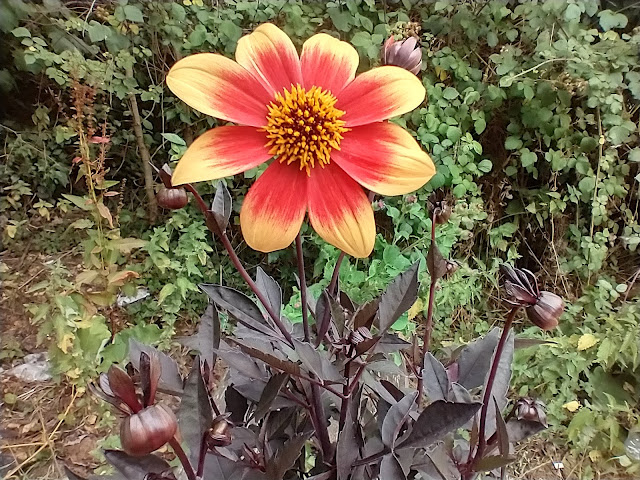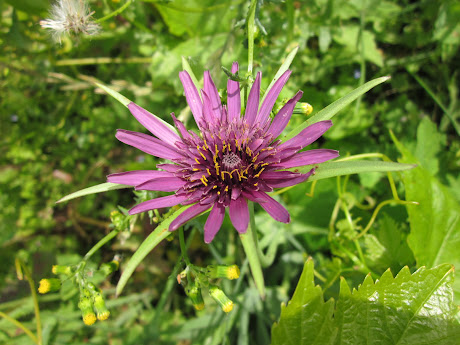Salad Days: Tomato 'Indigo Rose'
It's a couple of months since I introduced you to the black tomato I'm trialling this year, so I've put aside my salad leaves this month to bring you a full report on how they're doing.
'Indigo Rose' hails from Oregon State University in the USA and has been available there for a couple of years. We had a spontaneous exchange of experiences on the coach on the last day of the Portland Fling, so I'm not alone in the observations I'm about to tell you about.
This tomato was bred as a healthier option by crossing cultivated tomatoes with wild species from Chile and the Galapagos Islands. It's higher in anthocyanin (hence the purple/black colour), which are naturally occurring antioxidants in plants which may help to protect our nervous system, plus they may have have anti-cancer, antidepressant and pain killing properties.
.JPG) |
| Flowers and fruit - fairly large trusses of medium sized fruit are produced. You can also see the fruit's tendency to stay green underneath where they're not getting sufficient light. |
However, I think this may have been too early as the tomato was almost tasteless. The university's website says the fruit take around 90 days to ripen (which is fairly slow) and I've found that leaving the tomatoes as long as possible before eating does give them a better flavour.
Part of the problem is knowing when the tomatoes are actually ripe as there aren't the usual visual clues. A completely black tomato doesn't necessarily mean it's ripe. I've found if the fruit also has a slight give where it joins the stem, then it's time to pick. You also need to eat them quickly at this point, or if they've gone the colour shown in the picture as they don't keep that well.
Some do go completely red (and will be ripe) like the usual tomato. This is probably due to the anthocyanins varying in colour with pH. In the lab they're green-yellow in alkaline, purple in neutral and pink in acidic conditions. I've also noticed the red or browny-red tomatoes are much juicier than their more fleshy, black cousins.
.JPG) |
| NB the tomato size on this plate isn't representative - they're not cherry tomatoes. Most 'Indigo Rose' are 2-4 times the size of 'Sungold' |
Inevitably some tomatoes do fall off before they're ripe. These take a long time to ripen compared to their pictured 'Sungold' relatives. Note that 'Indigo Rose' is an open pollinated variety, so it's possible to save their seed. The jury is still out on blight resistance; I haven't had blight yet on any of my tomatoes, but then we've had a pretty dry summer thus far.*
* = and I'm also trying blight prevention using an aspirin spray which James Wong mentioned earlier this year.
The stems are more brittle than the other tomatoes I'm growing this year (Sungold and Moneymaker). When the remains of Hurricane 'Bertha' swept through the garden a couple of weeks ago, all my tomato plants fell like ninepins and some of the 'Indigo Rose' stems snapped (the other varieties just bent over). I've put the stems in vase on the patio making the most unusual bouquet I've ever had and to give the tomatoes a chance to ripen.
My final verdict?
Early to flower, yet longer to ripen; sturdy yet brittle plants; attractive fruit, yet difficult to know when ripe, this is a tomato with good and bad points which scores strongly on novelty value.
So far as a salad tomato it's rather lacking in flavour, though it has been improving with age. Perhaps late season is when it comes into its own? However, its fleshier fruiting habit means I've had a tastier success with salsa and sauce making, so perhaps this is where this tomato's true forte lies.
I've also heard there are further developments in this breeding line which are an improvement in the flavour department. So watch this space!

.JPG)
.JPG)
.JPG)
.JPG)










Thank you for evaluating this one. The characteristics you noted are important to know, especially the brittleness for someone like me who ties up plants rather severely. I read about Indigo Rose earlier this year and thought it was interesting. I hadn't realized it was a small one until you showed it with the Sungolds. I suppose if it takes off someone will be marketing it as the next "superfood," a term I'm not crazy about to say the least.
ReplyDeleteHi Shady Character - glad you found this useful. NB the tomatoes with the Sungolds are on the smaller side, most are quite a bit bigger than that, at least double the size and up to 4 times.
DeleteI've now put a caption below the plate of tomatoes pic, to explain the usual difference in size between 'Indigo Rose' and 'Sungold'.
DeleteSeveral blog posts featuring this tomato had me convinced I simply had to plant this tomato next year. Your evaluation has certainly taken the bloom off the 'Indigo Rose'. Brittle stems with our large, bushy tailed dog as well as color changes with our highly alkaline soil suggest the final result might not be a happy one. Thank you, my friend, for an honest assessment. Those other dewey, deep blue close-up shots certainly had me sold.
ReplyDeleteHi Vicky - lovely to hear from you :) I'm hoping the breeding experiments down the line give us something better to try... Looks like Lexa's comment below is promising...
DeleteAn interesting variety, I'm always on the lookout for different tomatoes to try. A shame the flavour isn't brilliant.
ReplyDeleteIt's a real shame. My teenage niece and nephew thought they looked really cool and any vegetable that a teenager is interesting has to be worth something right?
DeleteI've read several negative comments about this tomato from other bloggers, and only one positive one, so I doubt I'll be planting it. Trying to figure out just when it's ripe sounds a bit too challenging compared to other tomatoes, and I have to agree with vbdb about the brittle stems--our Golden Retriever also likes to check out the veggie garden. I am interested in the blight prevention spray, though, and will have to check that out--there are signs of blight in my garden already.
ReplyDeleteJust discovered your lovely blog. What a wonderful, thoughtful review you have given Indigo Rose. I live one hour south of Oregon State University and that is where I went to college ( Go Beavers!), so it was a bit of a thrill to see "our" tomato being grown in England. I think you are dead on with your review. The reviews from those who have tried it here are; it is pretty, great health benefits, but is almost completely lacking in taste. But just as you said, the rumor is the second generation has much improved flavor with the same health benefits. So we shall wait. Always something new to try each year for the gardener. That's part of the fun!
ReplyDeleteThanks Lexa and welcome :) We spent some time in Corvalis when we were in Oregon in July. It's a lovely town and what a coincidence to find I'm growing something that originated from there. Looking forward to seeing what the next generation brings...
DeleteThink that I will be giving this one a miss VP after reading your verdict on the all important taste factor. Thanks for sharing your observations.
ReplyDeleteThey're doing OK in sauces at the moment, but I was thinking today that anything which has to make a gardener act differently to what they're used to is going to make acceptance that much harder. The whole issue with ripening as well as taste is going to put a lot of people off.
DeleteI'm pleased you've posted this information as my Indigo Rose toms are at the green bum stage. All my toms are growing outdoors out of necessity but are grouped quite close together so it's perfectly feasible that lack of light is inhibiting ripening. My learning curve continues! Thanks for this, very useful information.
ReplyDelete'Green bum' - oh how I wish I'd thought of that term Caro!
DeleteI love the look of your black tomatoes.
ReplyDeleteDo you grow gooseberries? Mine are not fruiting this year so do you think I should prune them now?
Hi Marshmallow - I do grow gooseberries, but I'm thinking about taking them up this autumn as I have a problem bramble growing through the middle of them. Now is not the time to prune them and what you need to do depends on how you're growing them e.g. cordon or not. The RHS website has all the information you need. https://www.rhs.org.uk/Advice/profile?pid=332
DeleteI saw some of these growing on a rooftop kitchen garden in London recently, and apparently they need a LOT of sun. The ones I saw were a really deep glossy black, but they were in a very sunny position, and the gardener had taken off most of the leaves so that they weren't shaded at all. He said they have been bred deliberately to be less sweet. I tried 'Christmas Grape' tomatoes this year and I thought they had a weird taste - tomatoey, but as if they had been flavoured with herbs. Sounds nice, but ...no. I'm going back to 'Sungold' next year!
ReplyDeleteMine were in the sunniest part of the garden too. They're unripe when glossy black, the tomato goes just a little bit dull when it's ripe. I grew Sungold too which were as fabulous as ever, but they're long gone and I still have these on the go. They're definitely better later on in the season.
DeleteI tried Indigo Rose this year, 3-4 trusses is not bad for the north of England. It has had good disease and peat resistance so far. The only thing is that the leaves although looking healthy apart from a little leaf curl are nearly as black as the fruit, I boosted the calcium but no change, any thoughts.
ReplyDeleteHi - I remember my plants had noticeably darker leaves too. It didn't seem to affect the crop, so I suspect the plant as a whole has high anthocyanin levels, not just the fruit.
DeleteNB don't pick the fruit when they're black as they aren't ripe at that stage. Wait until they turn red... that's the sign they're ready to pick.
OMG this information about Anthocyanins making the leaves turn indigo colored as well is so helpful!! I'm growing two varieties right now that also have this dark blue color (Atomic Cherry Bomb and Kaleidoscope Jewel) and becasue of the color of the stems and leaves I've been furiously trying to diagnose what is WRONG with these plants and how to save them and keep them from spreading whatever it is to other plants (even though they seem to be fruiting just fine). I didn't know that was NORMAL for these varieties!!! whew!! Now I just need to deal with the mites that are destroying my herbs and nastursium XD
ReplyDelete